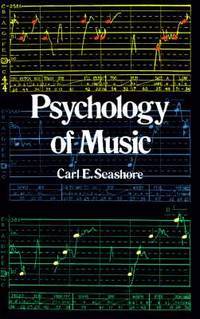
Psychology of Music Paperback - 1967
by Seashore, Carl E
- Used
Between the physical world of vibration and the world of consciously heard music lies a third area, which is the province of the psychology of music. This introduction, first published in 1938, by the developer of the Seashore test of musical ability, is a thorough survey of this field. A standard text for psychologists specializing in the area, teachers, or interested musicologists.
Description
Standard delivery: 5 to 9 days
Details
- Title Psychology of Music
- Author Seashore, Carl E
- Binding Paperback
- Edition Dover reprint ed
- Condition Used - Good
- Pages 448
- Volumes 1
- Language ENG
- Publisher Dover Publications, New York
- Date 1967-06
- Bookseller's Inventory # N15F-01921
- ISBN 9780486218519 / 0486218511
- Weight 1.2 lbs (0.54 kg)
- Dimensions 8.4 x 5.4 x 1.2 in (21.34 x 13.72 x 3.05 cm)
- Library of Congress subjects Music - Psychological aspects
- Library of Congress Catalog Number 67027877
- Dewey Decimal Code 781.15
About Wonder Book Maryland, United States
With 3 stores less than 1 hour outside the DC/Metropolitan area (1 in Gaithersburg, 1 in Frederick and 1 in Hagerstown, MD), we have the largest selection of books in the tri-state area. Wonder Book and Video has been in business since 1980 and online since 1997. We have over 1 Million books for sale on our website and another 1 Million books for sale in our 3 locations. We have a very active online inventory and as such, we can receive multiple orders for the same item. We fill those orders on a first come first serve basis, but will refund promptly any items that are out of stock. Since 1980 it has always been about the books. ALL kinds of books from 95 cent children\'s paperbacks to five figure rare and collectibles. A merging of the old and new is where we started, and it is where we are today. Our retail stores have always been places where a reader can rush in looking for a title needed for a term paper that is due the next day, or where bibliophiles can get lost \"in the stacks\" for as long as they wish. In 2002 USAToday recognized us as \"1 of 10 Great Old Bookstores\", and we have been featured in numerous other newspaper and TV stories including Washington Post and CSpan.
RETURNS are cheerfully accepted up to 30 days. We ship out within 1-2 business days and U.S. Standard Shipments usually arrive within 6-9 business days, Priority 3-6.
From the rear cover
Between the physical world of vibration, as measured by apparatus, and the world of consciously heard music there is a third area of investigation. Our auditory apparatus and/or mind separates different instruments and tones, hears some vibrations but not others, adds tones to fill out the sound spectrum, etc. This middle ground is the province of the psychology of music, a subject about which even many physical scientists know little.
This introduction, by the developer of the Seashore test of musical ability, is a thorough survey of this field, the standard book for psychologists specializing in the area, for the school, and for interested musicologists. It opens with the musical mind and with a series of chapters on music as a medium: vibrato, pitch, loudness, duration, timbre, tone, consonance, volume, and rhythm, dealing with each from the special point of view of the role of psychology. It then moves to such factors as learning, imagining, and thinking in music; the nature of musical feeling; the relative sound patterns of specific instruments and the human voice; measures of musical talent; inheritance of musical ability; primitive music; the development of musical skills; and musical aesthetics.
This wealth of material is supplemented with dozens of oscillograms and other sound-pattern charts recorded from actual play and singing by Jeritza, Caruso, Paderewski, Szigeti, Rethberg, Menuhin, Martinelli, and other artists. An appendix cites two attitudes toward the evaluation of musical talent and over 200 bibliographic references.


